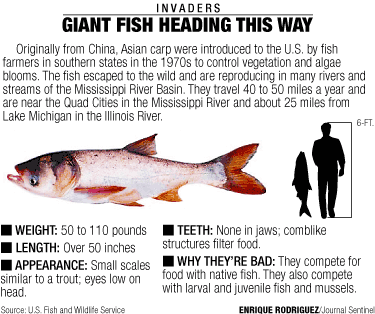ODN NOTE: This article was found
very interesting and worthy of posting here for everyone's
review. This Carp situation is NO JOKE!
Feds pass on surest solution to
Asian carp advance
By JOHN
FLESHER, AP Environmental Writer
John Flesher, Ap Environmental Writer
Associated Press story on
February 12 2010
TRAVERSE CITY, Mich. – The
surest way to keep rampaging
Asian carp
from gaining a foothold in the
Great Lakes
is to sever the link between
Lake Michigan
and the
Mississippi River basin, created by engineers in
Chicago
more than a century ago.
That would thrill environmentalists
and those who make their living in the $7 billion Great
Lakes fishing industry, which could be devastated by a carp
invasion. Not so the barge operators who move millions of
tons of commodities on the Chicago-area waterways each year.
And so, pulled in different
directions by both, as well as politicians in the
Great Lakes
states, the Obama administration this week proposed a
$78.5 million plan that appears to make no one happy.
"It appears to be politically
negotiated rather than scientifically based ... sort of like
trying to cut the baby in half," said Thom Cmar, an attorney
with the Natural Resources Defense Council. "It offers a lot
of middle-ground alternatives with no discussion of why any
of them would actually work."
Shippers worry about a promised
study that would examine closing more often a pair of
navigational locks at Chicago, and the prospect that a
long-term study could recommend severing the connection
between the river and the lakes for good.
Environmentalists, meanwhile, fear
the plan's reliance on strengthening an electric barrier
designed to block the carp's advance — and other measures,
such as stepping up efforts to find and kill fish that may
have slipped through — is an expensive gamble that might not
be enough to ward off an infestation.
"We're spending close to $80
million just for a short-term deterrent," said Joel
Brammeier, president of the Alliance for the Great Lakes, an
environmental group. "We need to stop pushing money toward
temporary solutions and get everyone on track toward
investing in one that works for good — and that means
absolute physical separation."
Bighead
and silver carp — both native to Asia — have been migrating
toward the lakes since escaping from Deep South
fish ponds
and sewage treatment plants in the 1970s. The biggest can
reach 100 pounds and 4 feet long, consuming up to 40 percent
of their body weight daily in plankton, the base of the
aquatic food chain. Once established in the lakes, the carp
could starve out the prey fish on which popular species such
as salmon and whitefish depend.
The carp have already infested
parts of the
Mississippi and
Illinois
rivers, driving away many native fish.
Silver carp
are known to hurtle from the water at the sound of passing
motors and slam into boaters with bone-breaking force.
While scientists differ on whether
the carp would thrive in the Great Lakes, which are colder,
deeper and ecologically different than rivers, many say the
risk is too great to take any chances.
"None of us know for certain what
their impact would be," University of Notre Dame biologist
David Lodge told a House subcommittee this week. "There's
only one way to find out, and I don't think any of us want
that."
To be fair, the solution
environmentalists prefer — cutting ties between the lakes
and the Mississippi — would mean reconfiguring some 70 miles
of canals and rivers. That's a massive undertaking that
could not happen quickly. "We cannot fight biology with
engineering alone," Cameron Davis, the
Environmental
Protection Agency's spokesman on the issue, told the
congressional panel.
Yet the federal plan is heavy on
technological innovations. Among them: barriers using sound,
strobe lights and bubble curtains to repel carp and
biological controls to prevent them from reproducing.
They're promising measures, but still on the drawing board.
Environmentalists and
Great Lakes
governors outside of
Illinois
who want to close the
Chicago locks
claim it's the best short-term option. But it isn't a
foolproof solution, as young carp might still be able to
slip through the leaky structures. The Chicago waterways
also have other access points to
Lake Michigan.
Army Corps of
Engineers officials are putting their faith in the
two-tiered electric barrier in the
Chicago
Sanitary and Ship Canal about 25 miles from Lake
Michigan, to which they will add a third section this year.
It emits pulses to scare off the carp or knock them
unconscious if they don't turn back. No carp have been found
above the barrier, although biologists have detected their
DNA in numerous spots past it and even within the lake
itself.
"While we're all talking," Lodge
said, "the fish are swimming."
That almost certainly means at
least some carp have eluded the device and reached the lake.
The government's plan aims to keep their number low enough
to prevent them from breeding. The problem is that no one
knows how many carp need to make it into the lake to
establish a foothold that can't be turned back.
"This is a lot of money to pile
into stopgap measures," said Phil Moy, a University of
Wisconsin Sea Grant researcher. "It may do some good in the
short term, but in the long term it's not going to solve the
problem of
invasive species on both sides of the divide.
Ecological separation has to happen for this to be
successful."
___
AP Environmental Writer
John Flesher
has covered the
Great Lakes
since 1989.


